Review of HP Pavillion d4600y Desktop With E6600 Processor
There's been a lot of interest in the new Core 2 Duo chips from Intel
and the Conroe chips in particular for those of us looking for new
desktops. These chips were released in July and I saw that HP was
selling their d4000 desktops with these chips on July 27. I ordered one
with the E6600 (2.4 Ghz) processor with 2 GB of memory and
took
the default options on everything else. The price came to $1189 with a
ship date of August 3 which was pretty good for a chip in high-demand
and where Dell's ship dates were further out and their prices higher
for a similar system.
After ordering the system, I found that we have an employee discount
agreement with Hewlett Packard. I called up their customer service
department and asked them if they would honor the discount after the
sale. To my surprise, they did! And they knocked about $70 off the
price of the system, issued as a credit. I was quite impressed as I
don't think that they really had to do that.
August 3rd came and I received an email from HP stating that they were
pushing the ship date out a week to August 10. I was pretty
disappointed but was very busy at work so not having the system wasn't
a huge deal. And HP emailed me a $50 coupon for the inconvenience.
I thought about cancelling my order and then reissuing it with the
coupon and changing the video card and did send them an email to do so
but changed my mind when I found that the upgraded video card wasn't a
great choice either. The base machine comes with an nVidia 7300 (64 MB
with TurboCache that uses system memory). The upgraded card is the
nVidia 7500. I wound up uncancelling the order so that I wouldn't lose
my place in line.
The system actually shipped a day early from the revised date and
arrived a day early from the estimated arrival date. The arrival date
was Tuesday, August 15, 2006.
I posted a note on MozillaZine asking about video cards and received a
few replies indicating that I should look at the nVidia 7600 GT. I had
a look and liked what I saw as a good compromise between price and
performance. The HP comes with a 350 Watt power supply which should
handle the 7600 GT's power needs.
I bought a d4500e back in June and it arrived in the same kind of box.
Just a plain cardboard box with clear tape, the packing slip and a few
stickers on the side of the box. Now the packaging doesn't really
matter that much but I always did like the look of the Dell boxes as
you knew that the box was from Dell and you could tell that Dell spent
a little more on the packaging as the box quality was higher.
Why am I mentioning the box that it came in? Well, this box is really,
really deep and I knew that it wouldn't fit in the trunk of my car
(from previous experience). So I would have to shoehorn it into the
back seat as before with very little room to fit it through the door.
The box has a lot of empty space in it and I'd guess that HP could
reduce the size of the box to make it easier to transport. I checked
the size of the box for my last Dell desktop (Pentium 4 Celeron 1.8
Ghz) and it is quite a bit shorter and would fit in my trunk. I think
that Dell uses more protective packaging material so that they can make
the boxes smaller.
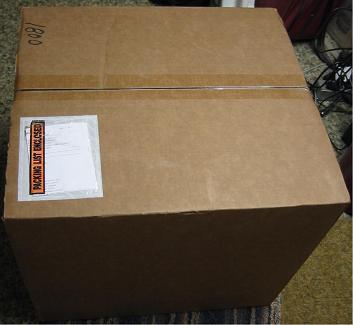
I opened up the box and was greeted by one of those big, multilingual
sheets of glossy paper that tells you about the machine connectors.
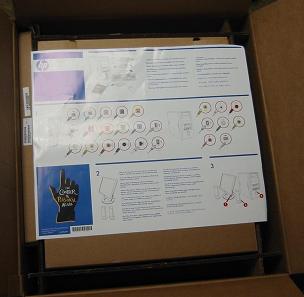
I removed this and there were two boxes side-by-side. One of the boxes
was empty. The other contained the mouse, power plug and some
documentation and free trial offers. The keyboard was in a narrow box
to the left of the cover sheet as you can see in the picture above.
The system was in protective styrofoam and wrapped in plastic.
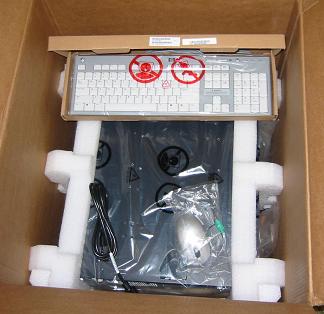
The machine looks just like the d4500e (Athlon X2 4400+).
As you can see, it's a fairly tall machine.

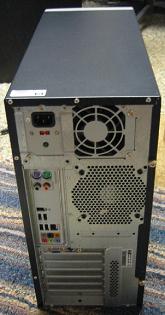
In the back of the machine there are several ports. The far left ports
are for the keyboard and the mouse. The ports to the right are for
digital audio. Then there's a Firewire port, two USB ports, another two
USB ports and an Ethernet port and then three ports for six speakers
and three of the usual audio ports. The d4500e didn't have the digital
audio and six speaker ports.
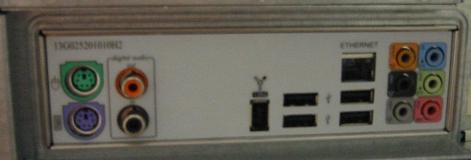
The expansion slots in the back reveals the PCI-Express video card
outputs along with what appears to be six additional card slots. There
are actually five PCI slots that are open. But the slot next to the
PCI-Express card would be a very tight fit given the size of the nVidia
7300 graphics card.
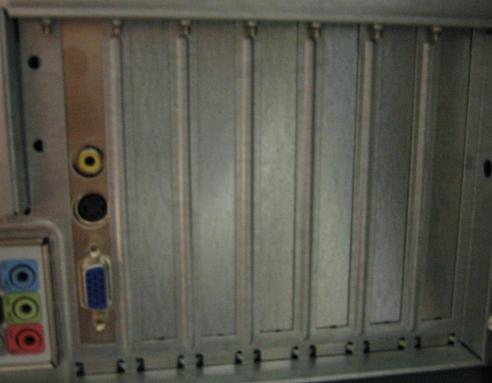
Here we can see the upper part inside the box. On the right, there are
three 5 1/4 bays open and one 3 1/2 inch bay available. One of the 3
1/2 inch bays is taken by the flash memory readers while one of the 5
1/4 inch bays is used by the optical drive. The box has the feel of a
lot of open space and room for expansion.
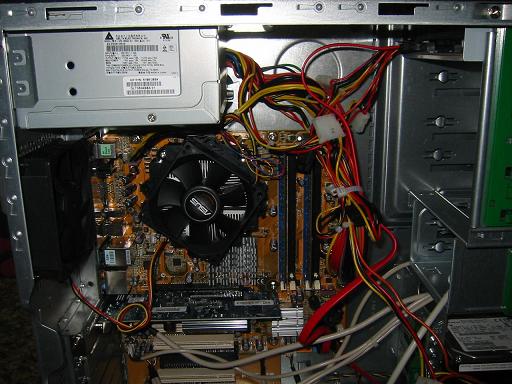
In this picture, you can see the 3 1/2 inch disk drive on the right.
There's room for at least one more down there.
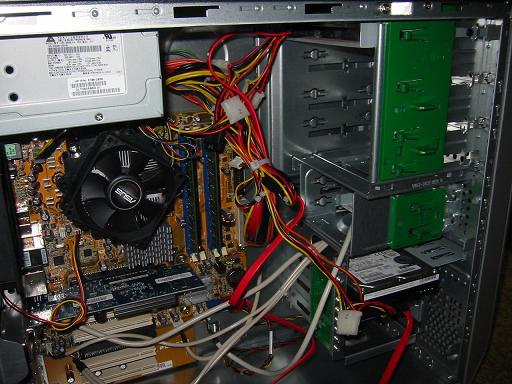
This is close shot of the motherboard with a better view of the PCI
slots.
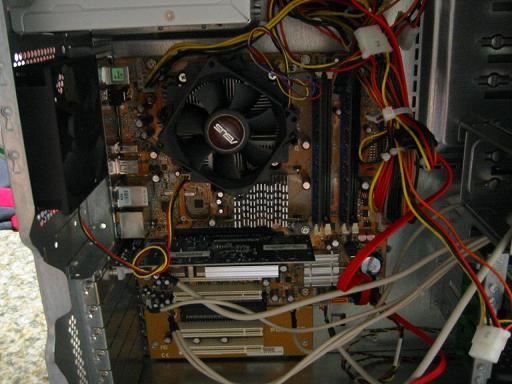
Next is a closer view of the DIMMs. Note that there is one card per
slot-pair which seems a little unusual to me. Usually you fill one slot
pair if you only have two memory cards.
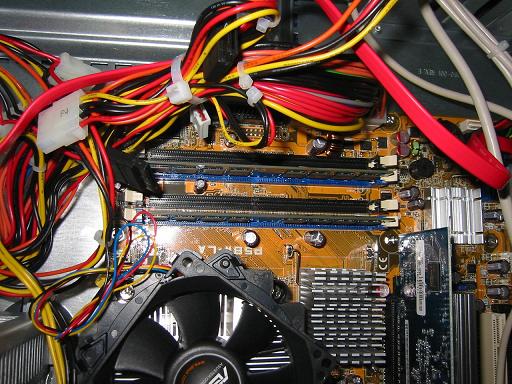
And our final picture shows the flash card slots, and USB, Firewire and
audio jacks for convenience.
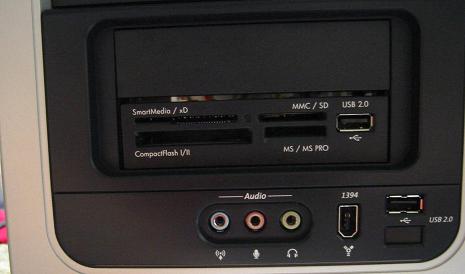
I got the system up and running with little effort. It comes with
Windows Media Center and a lot of trial software which I really don't
like but it probably keeps the price of the hardware down. Someday,
I'll have to go and try to remove it all. In the meantime, I'm using
Norton security. When the free trial runs out, I'll probably use
something else for Antivirus and Firewall.
I ran some simple Javascript benchmarks on the Conroe and it did very
well compared to my Athlon 64 3200+ notebook (Socket 754) running
Windows XP Home and the Athlon X2 4400+ desktop running Windows XP
Professional x64 Edition. I will do some more benchmark testing in a
future article. But my general feeling is that the Conroe system
responds crisply whereas the X2 system responds smoothly. The X2 is a
little faster and doesn't get bogged down by background tasks. I use
the 3200+ daily so that's what I am most used to.
The Conroe system response has a jump-feel to it. Basically the
difference between it and my 3200+ is noticeable in my browsing. I
haven't had the time to set the machine up for normal tasks so browsing
is all I'm doing with it at the moment.
Overall, it is a very nice system for the price and I think this makes
for a very nice midrange system. We've been very happy with the X2
system as well and I've been overall very impressed with our three
products from HP.
Day 2
I did some additional testing last night with more benchmarks and I
noticed some unusual results when the desktop is in EnergyStar mode but
I'll do more thorough research at some point in the future.
One very pleasant thing about the new system is how fast it boots. The
boot times have dropped considerably from my 3200+.
I had to reboot as Windows Automatic Updates downloaded and ran another
update for me. It ran a few of these yesterday too.
I also enabled the Norton security suite and noticed that this puts a
small drag on browsing performance. Norton does antivirus, firewall and
antispyware which could be slower than my usual combination of
ZoneAlarm and Avast or just Avast and Windows Firewall on our other
machines. I recall using Kerio Personal Firewall some time ago which
provided a lot of functionality including blocking a lot of web ads but
I didn't like the performance drain of the product. It seems that more
and more computer cycles are being used to fight malware and ads these
days.
I found the HP provides a page describing some of the bundled software
on your machine. The page that I found didn't exactly match the
software on the Conroe but does cover many of the programs that are
preinstalled. One nice improvement that HP has made lately is to group
all of the shareware/trial games into one program making it far easier
to drop all of these in one step. You can find this page at HP
and Compaq Desktop PCs - Uninstalling Software in Windows XP.
Included in the package are Microsoft Money, Quicken and Microsoft
Works. I removed Microsoft Money but left Quicken though I'll probably
get rid of that at some point. I also left Microsoft Works in case I
need that soon. I generally use Open Office or Google products for
Office Productivity tools on my own hardware unless someone buys me a
Microsoft Office license as is the case with my laptop. But that's
something to install at another time.
Next up is to create the recovery disks. I fired up the Recovery CD/DVD
Creator program and it told me that I would need three DVDs to do the
backup. I looked around the basement for blank DVDs and found three
blank DVDs, one with a slightly damaged jewel box. So I kicked off the
process, inserted the blank disks when asked to and it finished in a few hours. Fortunately I have a two monitors on my desk so
that I could work on my laptop while doing system setup tasks on the
Conroe.
The machine seems to be in generally good shape now and ready to
install my applications which means that this is a good place to end
this article.
Addendum
I setup the Norton Antivirus fully intending to dump it for Avast and
Zone-Alarm but I found a problem with Norton and Standby mode and
decided to dump Norton to get Standby to work. What would happen is
that I would put the computer into Standby mode and then it would wake
up about a minute later. I closed various applications until I found
that Norton caused the problem. So I deinstalled Norton and installed
Avast and all is good with Standby. To HP's credit, the trial period
for Norton is about 15 months which is really long for a free trial.
Next up is installing Zone-Alarm or just using Windows Firewall.
And one final note about Windows: it's been downloading and installing updates like crazy yesterday and today.
Day 3
I set up my system to connect to the office and installed NVU for
writing. I also installed Thunderbird Email and played around with the
video settings. I found out that the nVidia 7300 LE that came with the
system has 256 MB of onboard RAM. HP's website states that this video
card offering only comes with 64 MB of memory onboard which is why I
decided to upgrade the video. I'll have to send HP a note on this so
that they can update their website.
I also hooked up my 24 inch Dell monitor to the machine and put the 17
inch monitor on my laptop and have been using it this morning with
Tarantella and my usual daily tools and it is a dream to use. I think
that this machine represents the sweet spot of price and performance
today.
September 1, 2006
I finally ordered the nVidia 7600 GT from Newegg. $120 after rebate
with three-day shipping. So that should be fun when it arrives.
Also stopped into CompUSA and bought a D-Link 10/100 Fast Ethernet
Desktop Adapter. You may recall that I couldn't find a driver for the
Intel integrated network on the machine. I mentioned this to a coworker
who had the same problem with a Gateway X2 4200 system on Windows XP
Pro x64 Edition and with Linux. He went to CompUSA and bought a cheap
D-Link NIC and he said it worked. I contacted D-Link and they flat out
said that they don't support x64. But my guess is that their Network
Interface Cards can work with the drivers on the x64 installation disk.
So I popped it in, installed the drivers and it worked. For a little
while. Then the network died. So I rebooted and tried again. Didn't
work. So I reinstalled x64. The installation died so I tried doing it
over again. This time I couldn't get the screen to come on. So I tried
10 power reboots and no output from the video card. I was thinking that
I fried something....
Maybe the video card. So I opened it up and took out the new NIC. And
the machine booted up. Installed x64 but no network. Opened up the
machine again and reseated the card. The thing was really hard to get
into the PCI slot in the first place. After that the network card was
fine on both x64 and Windows XP Media Center.
I installed the nVidia driver on x64. The installation was very smooth.
But they have a new interface build into Windows Explorer. And I hate
it. The old little window was better. But I shouldn't need to go into
it very often after I get the new video card up and running. The main
reason that I needed it was when the Dell monitor was a little fuzzy.
Changing the resolution to something else and back again would fix the
problem. The new video card has DVI so that won't be a problem in the
future.
I ran BenchJS using my Win64 Firefox 1.5.0.6 and I think that it's
going to show a nice edge over Win32 results. It will take me a while
to get all of my stuff installed of course. And there is one other
little problem: the system drive is H:, apparently due to all of the
built-in flash drives in the machine. I would like to change it to D
though I'm not sure that can be done safely. If I have to live with H,
I'm going to have to change my Firefox build scripts as they assume D:
for cygwin and patches.
One other minor detail on running x64 on this HP Pavillion: I'll need a
sound card with drivers. But I can live without sound for testing. I
couldn't live without ethernet.
September 6, 2006
I picked up a Creative Labs SoundBlaster Audigy SE for $30 at
Staples and the nVidia 7600 GT arrive via UPS. I replaced the nVidia
7300 with the 7600 GT and booted it up in 32-bit mode. When I booted it
up, there was no network. So I put the Ethernet cable on the integrated
Ethernet and I had internet access. I downloaded the latest nVidia
32-bit drivers and was up and running a little while later. Then I
repeated this for the x64 side but had the same internet access problem
as the integrated Ethernet doesn't work on x64. So I switched the
Ethernet cable to the NIC and that worked fine. Downloaded drivers
again and installed them and all was fine.
I'm using DVI on my Dell 24 inch monitor and VGA (nVidia card comes
with two DVI to VGA adapters) on the Dell 17 inch monitor. The Dell
monitor is hooked up via a Belkin KVM to switch the Dell 17 inch LCD
monitor, my keyboard and my wireless mouse between the Conroe and my
Athlon 64 3200+ laptop.
I then installed the Audigy card in the bottom PCI slot (the NIC was in
the slot next to the bottom of the case). Booted up in x64 and ran
setup.exe from the drivers section of the included CD. It installed the
drivers, rebooted and I had sound. I repeated this on the 32-bit side.
So I have sound, internet and pretty decent video on both Win32 and x64
and we're all ready to start installing applications on x64. I would
like to get iTunes installed as I mainly listen to one of the radio
stations on iTunes and I've heard that the latest version won't
install/run on x64 so I may have to do some fiddling and diddling with
older versions or use Windows Media Player (gasp).
While installing the cards today, I encountered one small issue which I
consider a quality issue. If you look at the pictures inside, you'll
notice one pair of beige wires that are crossed. These two wires make
it harder to populate the middle PCI slots. It can be done but you'd
have to move the cross-point further towards the right. I haven't
traced the beige wires to actually see what they are but I'd guess that
they are for the multimedia flash readers, the front sound ports and
the front USB 2.0 and Firewire ports. The convenience ports on the
front are nice but it means that the assembler has to be more careful
with the wiring. I don't plan on adding any more cards at this point so
this isn't an issue for me anymore.
October 28, 2006
After about two months with this machine, I can say that I like it in
every way except for one of the main reasons that I bought the machine
for and that is in building Mozilla Firefox. I had several reasons for
buying this machine:
- A desktop to drive two LCD monitors (my laptop only has one video out and it's analog).
- Build Mozilla products on both Win32 and Windows XP x64 edition.
- A machine that can play songs (mostly from Radio Skipper on
iTunes), PodCasts (from financial shows) and a DVD movie from time to
time.
- A machine to VPN into work. Our office uses a VPN with only
32-bit Windows support but I installed Microsoft Virtual PC on my
laptop and got our VPN client to work in a Win32 Home Virtual Machine
under a Windows XP Professional x64 edition host operating system so
I'm planning on using this setup for the Conroe. I have two Windows XP
Home licenses on order which should arrive in the next week. I
generally prefer to run Windows XP x64 edition all the time and would
rather not have to boot into Windows Media Center on the 32-bit side.
The other advantage that using a Virtual Machine has is that it really
partitions your environments. All of my work email, programs,
etc. will be on a VM while everything else that I do doesn't have to go
through the VPN. No sense getting my iTunes feeds through the Corporate
VPN, right?
- A game machine for the kids to use if I'm not around. This hasn't
materialized as they reported problems running on the Conroe with some
of their games. They're pretty set with the equipment that they have
anyways.
- A machine to play around with the new Intel architecture and one that would have enough compute power for the next five years.
I'd say that this machine generally satisfies the needs above except for the performance on building Mozilla products.
Mozilla uses the Gnu tools along with Microsoft's C/C++ compiler tools
on Windows and for some reason, this combination of tools runs slowly
when developing in the Windows XP x64 environment.
I was really shocked when I first tried building as the Core 2 Duo
machine took about twice as long as my really old Compaq laptop with an
Athlon 64 processor at 2.0 Ghz. The Conroe has faster disks (7200 RPM
vs 5400 RPM) and the Compaq disks are notebook drives. I was a bit
stumped as to why the Conroe was so slow in this area and only recently
tried an experiment with setting the build images to uniprocessor mode.
I think that the tools are built to run multithreaded or maybe in a
multitasking mode but that this is counterproductive due to the cores
invalidating the cache as they try to work on or with the same data. I
used a Microsoft tool called ImageCFG to set the build images to
Uniprocessor mode. These included the cygwin tools, the Mozilla build
tools and the Microsoft language tools. This improved build performance
to the point where CPU usage was 60 to 100 percent of one processor.
But general compilation and build performance still lags the old laptop
when I just scan the rate of output from two builds running at the same
time on the different machines. One area that Conroe shines in is in
links as it outperforms the Athlon 64 in this area.
It's still a pretty big disappointment and I'm still building on my old
laptop for now. One benefit of the Conroe here is that I can remote
desktop into my laptop from the Conroe so that I can use the big screen
to use the laptop.
I plan to test out build performance on the Athlon X2 4400 desktop if I can get some time on it.
November 4, 2006
Firefox Build Performance
The machines used for the performance test were:
- Compaq
Presario r3000z Athlon 64 3200+ (2.0 Ghz, 1 MB L2 cache, Socket 754, 89
Watts), 2GB RAM, 100 GB 5400 8 MB Cache disk. This machine was
purchased May 2004 and is currently my main build machine.
- HP
Pavillion d4100e Athlon X2 4400+ (2.2 Ghz, 2 MB L2 cache, Socket 939),
2 GB RAM, 7200 RPM disk. This machine was purchased around May 2006.
- HP Pavillion d4600y Conroe E6600 (2.4 Ghz, 4 MB L2 cache), 2 GB RAM, 7200 RPM SATA disk. This machine was purchased August 2006.
The
build disk was the same in all of the testing: a Hitachi TravelStar
5400 RPM Notebook drive in a USB 2.0 enclosure with an 8 MB cache.
The test involves running a Mozilla Firefox x64 build up to the first failure point.
This
particular build requires several steps where you start the build, it
failes on something, you fix that and then restart the build. The first
failure point has to do with copying DLL and manifest files and is
fairly early in the build which makes it nice for doing a quick
benchmark. The build does a fair amount of configuration work a lot of
compiles and a few links in the GNU tools for Windows environment
(CYGWIN). So in many ways, this test represents a piece of a real world
portable build environment.
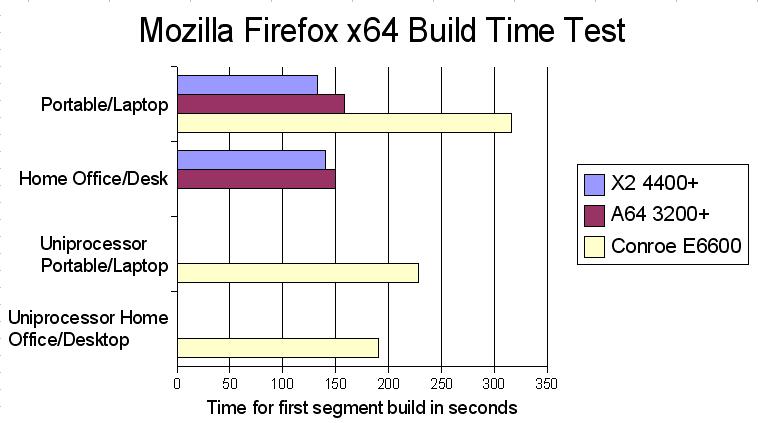
Note
that the results for the Conroe Portable/Laptop test are calculated
from the 3200+ test. I ran a timing test between the two some time
earlier and noted that the time for the Conroe was about twice the time
for the 3200+. I was unable to reproduce the original test as I had set
the images to Uniprocessor mode on the machine and couldn't figure out
how to turn off Uniprocessor mode using the ImageCFG tool.
Portable/Laptop
vs. Home Office/Desktop refers to the Microsoft Windows XP power
settings. Portable/Laptop is essentially a low-power mode.
Interesting points:
- I
watched the Task Manager Performance display while doing the builds and
the CPU utilization on the Conroe was pretty low on both cores with
affinity not set. I suspect cache conflict problems as the culprit in
the low multiprocessor Conroe results.
- The Task Manager
Performance display on the X2 were generally over 50% implying some
benefit to using a dual-core AMD processor over a single-core AMD
processor. The percentage performance improvement, however, was only
single-digits above what would be expected from the 10% frequency
increase of the X2 over the 3200+.
- The X2 results were slower
under Home Office/Desk mode than they were under Portable/Laptop mode.
I ran these tests twice to confirm the results. It appears that the
higher power mode may cause more conflict issues that actually slows
things down a little bit.
- There's a fairly decent performance improvement going from Portable/Laptop to Home Office/Desk on the Conroe.
- There
is very little difference between Portable/Laptop and Home Office/Desk
on the 3200+ as it spends a lot of time at or near 100 percent CPU
utilization.
So it appears that the best machine for me to do
builds on is the X2 4400 but it isn't my machine so I won't be using it
for builds.
.
Last Updated November 4, 2006.
All trademarks used are property of their respective owners.

